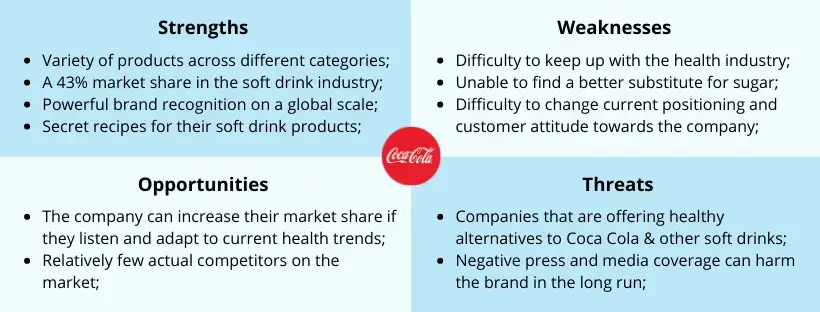Running a business means constant checking of all company procedures to make sure everything is optimized and going as smoothly as possible. Asking questions and probing into every cog in the system will inevitably lead you to discover problems or issues that need to be fixed. No business is ever 100% complete and every little process is always a work in progress.
This means that you are likely to make considerably significant business decisions, which can be intimidating. Adding to that is the pressure of having to do well for the sake of a business that you’ve already worked so hard for and the idea that, most likely, there are employees whose lives could be affected. There are many great tools out there that can be helpful in making informed decisions. One of them is the SWOT analysis.
SWOT is a deep analytical dive into gathering information. But for you to fully understand the concept, we must take a few steps back and define the 4 W’s. Who, What, When, & WHY would anyone conduct SWOT analysis? What’s the purpose of it?
And then, most importantly, HOW do you do it?
Keep reading and you’ll discover the 4 W’s and a step-by-step guide to actually following through with research and analysis.
Let’s start with the 4 W’s.
WHAT is SWOT analysis?
While the previous blog post on competitive analysis analyzed your competitors, SWOT analysis is an internal research tool that is used to evaluate your own company’s competitiveness. SWOT stands for strengths, weaknesses, opportunities, and threats. The identification of these four will greatly help your company to develop new strategies or help in making considerable marketing decisions. The elements needed for this tool are very straightforward as represented by the acronym, but can be divided into external and internal factors. S and W are under internal factors because they are general factors surrounding the makeup and performance of your company. External factors include opportunities and threats. The latter elements are elements that are typically difficult or impossible to control.
Strengths
The strengths of your company include a general evaluation of your performance. (Is the company doing well?). You can also include what your company’s strongest assets are and where you excel. Other internal factors under strength include your financial, physical, and human resources, as well as ongoing internal processes.
Weaknesses
For this element, you can ask yourself: What are our low-performing products or services? Or, what detracts from our brand? What resources do you have that are fewer than others? You can also try to look at it from the point of view of others. What aspects of your company are others likely to see as a weakness?
Opportunities
The first external element in this tool is opportunity. Look at the current market trends and see what opportunities are open for you. Or, you can look back to your strengths and see how you can turn them into opportunities.
Threats
The last element is threats, which is also an external element. You need to look at the market, even competitors, and determine possible threats that could harm your business. Again, go back to one of your internal factors, or weaknesses, and see how those could expose you to certain threats.
WHO CONDUCTS SWOT ANALYSIS?
Who’s conducting SWOT analysis? Because the possibilities of SWOT analysis are endless, everyone in the company can do the analysis, ranging from top-level executives to entry-level employees. However, we’ll be giving examples specific to the marketing department from hereon. Oftentimes, marketing teams and their respective project managers make product and advertisement-related decisions. However, it’s important to remember that since SWOT analysis requires looking into many different factors, both internal and external, you’ll need to use a lot of different resources. One advantage of conducting SWOT analysis is that it allows the company to use different data sources. While the project managers and marketing team are going to compile information and identify their findings, everyone needs to cooperate for a more comprehensive and accurate analysis.
WHEN IS SWOT ANALYSIS CONDUCTED?
Generally, SWOT analysis is done during strategic planning sessions or company meetings to allow for a longer time to brainstorm and analyze the current performance of the company. However, it would also be a good idea to conduct a SWOT analysis whenever a big decision needs to be made. Whenever a SWOT analysis is conducted, you need to make sure that it is done in an inclusive and constructive manner. Inclusive, as in making sure that everything is taken into consideration and constructive so as to avoid unnecessary or destructive critiquing of different teams or departments. It has to be done in a friendly, respectful, and relaxed environment so that people are not too intimidated to state their opinions.
WHY CONDUCT SWOT ANALYSIS?
While “why” is the last of the Ws, it’s definitely not the least important. On the contrary, it’s arguably the most important as it tells us why we need to bother doing this analysis. It is a time-consuming venture with a lot of considerations needed. However, the results and even the process of doing the analysis will give so much value to your company. Here are some of the reasons why:
Can be applied to almost any business decision
It’s a very flexible system that allows you to answer a variety of business questions. What you focus on for completing the table (more on this later) will deepen your understanding of your business in the context of a specific question.
Helps manage complex problems
Because SWOT analysis allows you to list very specific factors, you are also able to break down complex problems into smaller forms that will be easier to analyze.
Holistic awareness of all factors
Companies often fall into the trap of hyper-focusing on internal factors in decision-making. SWOT, on the other hand, requires considering external factors which contribute to a more holistic approach. The external elements include opportunities and threats.
Expose blindspots
Considering both internal and external factors will help you identify blindspots that might contribute to your company’s weakness or could prove fatal for the company’s progress later on. The analysis allows you to spot them earlier and preemptively address them. These blindspots can be included under your W (weakness) element.
Overcome challenges
Answering a business question with the use of SWOT analysis will help the company be in a better position to overcome challenges. These challenges can be found by analyzing the W (weaknesses) element in conjunction with your T (threats) element in the SWOT table. Shying away from the threats or weaknesses of the company can only prove dangerous, and it’s better to address them head-on.
Uncover new opportunities to pursue
Knowing your strengths and considering your weaknesses will allow you to identify if there are any opportunities you should be taking advantage of and how. These opportunities can be found using your S (strengths) element or shown directly in the O (opportunities) element in the table.
Not extremely costly
Lastly, the analysis does not require a lot of financial costs. Sure, it needs focus and effort, but the company will only be better for all the valuable information that the analysis will provide.
HOW DO YOU DO IT?
Step 1: Identify the objective
First, you need to know the objectives of conducting SWOT analysis. Are you merely doing a general health check for the company? Or, are you trying to gather information for significant decision-making? Knowing what the objectives are will help you better understand which information is relevant. A broad SWOT analysis will still be useful but having a more direct objective will produce more detailed and specific results. For example, you have a particular product that’s not doing too well so you’re debating whether to discontinue the product or if improvements will be worthwhile. In this case, the SWOT analysis will tell you clearly what its strengths are, if there are any opportunities for improvement, competition in the market, and its weaknesses. The output of the analysis will be the decision on whether to improve the product or discontinue production.
Step 2: Gather resources
Since there are so many questions that can be answered with the help of SWOT analysis, there’s no one set of resources that can be used every time. You’ve already set your objectives, now you can check which departments or parts of your company you can get relevant information from. If you’re doing a broad or general analysis, you can get general information from all departments and consolidate them. If you’re trying to solve the same problem mentioned in Step 1, you can ask for more specific information from each department. You can ask for the product’s total sales from the Sales department. Information on how it’s advertised from the marketing department can also be very useful. The marketing department is also usually responsible for production decisions so it’s very likely they will be the ones conducting the analysis along with general management.
Step 3: Compile ideas
The SWOT analysis is commonly laid out using a simple table for easier viewing. Using this table, you can see all the elements in one glance, allowing you to make connections easier and see the whole picture. Here’s what it looks like:

You can start by using sticky notes or simply writing all the ideas under each element. This can even be a fun team assignment! Everyone can take turns writing their ideas, don’t worry about there being too many or some ideas not being very relevant. Consider it a warm-up exercise to get the gears turning. There’s no wrong answer! Everyone should participate and express themselves, which could also inspire others and result in more creativity or in-depth thoughts about the issue at hand. You’ll be discarding some of these ideas in the next step.
Step 4: Refine findings
You’ve succeeded in putting all your ideas onto paper which can be overwhelming if there are too many. You’ll have to discard some. Now, we’re not saying any of them are “wrong”. Again, there are no wrong answers! It’s simply a matter of priority and relevance.
Also, the discarded ideas have served their purpose; inspiring more ideas. You can even put some of them in your back pocket so you can revisit them at a more appropriate time. You need to read each idea one by one, consider them carefully, and keep which are relevant to the objective you’ve previously set.
After choosing which ideas make it to the final list, you need to decide the order of priority for each element. There will be debates, but don’t worry. So long as you all remain respectful and open to each other’s ideas, you can reach a conclusion that everyone can agree on. For this stage, you can also enlist the help of other higher-ranking members for input.
Step 5: Develop the strategy
The SWOT analysis is ultimately a strategic-planning tool. The research you’ve done and the information you’ve gathered will be used to develop strategies consistent with the company’s values and goals and more specifically, the objective you’ve set in Step 1. You need to synthesize all your findings to help in accomplishing your objective. In the example that we’ve mentioned in Steps 1 & 2, you might find during the analysis that the product is not performing well because it’s not marketed as well as it should be. You might develop a marketing strategy that would hopefully present the product’s benefits and features better to the target market to increase awareness and, ultimately, sales. You can also decide on the duration to put the strategy in place. For example, you can revisit the product in 6 months and see if the updated strategy is performing better.
It may seem difficult to imagine using this business tool in real life. However, we assure you that it’s something that works for small businesses and major corporations alike. Let’s take the Coca-cola company as an example. Coca-cola is a giant company that has over 500 brands across its 200 companies. However, it is still possible to make use of the SWOT analysis to identify the company’s annual status or for specific decisions concerning its established systems or processes.
Here is Mktoolboxsuite’s sample SWOT analysis for Coca-Cola.

You can see more examples of SWOT analysis for popular companies here.
The SWOT analysis is fundamentally a guide in strategic planning and making decisions in a company. It also allows for more active participation from all team members to complete, inspiring collaboration and good rapport within departments.
Are you looking for more tools to scale your business? We can help you with that! Visit Strikepoint Media for a free strategy session or read our blog for more articles on digital marketing.




